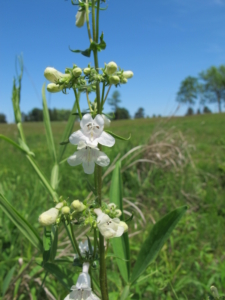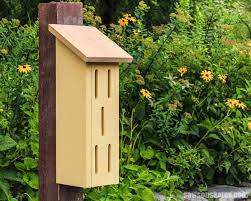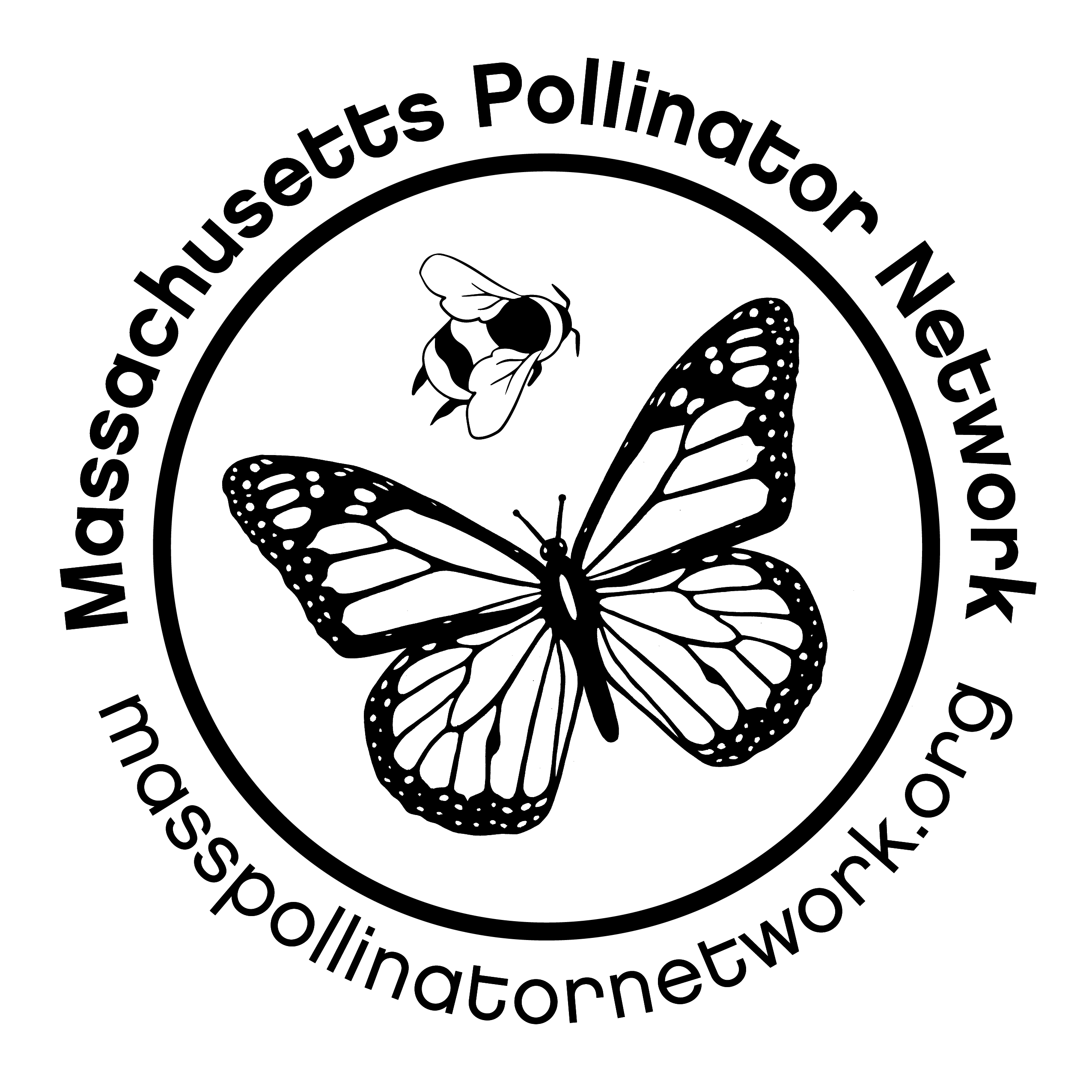-
Create & Manage Pollinator Habitat
“From expansive meadows to backyard butterfly gardens and everywhere in between — every landscape can be optimized to support pollinators. Growing the right flowers, shrubs, and trees with overlapping bloom times is the single most effective course of action to support pollinators from spring through fall.”
– Xerces Society for Invertebrate Conservation
Habitat loss is a leading cause of pollinator declines around the globe. The remedy? Protect, steward, create, and restore landscapes that sustain flower-visiting species and other wildlife. This endeavor can take many forms, and no matter your circumstance — whether you are the manager of many acres or a city-dwelling community gardener — there is something you can do to help! Below you will find actions and resources related to creating habitat for pollinators in New England.
 “Pollinator habitat” can be defined as areas that provide the food and shelter resources that flower-visiting insects, namely bees and butterflies, need to survive. For bees, high quality habitat contains undisturbed places to nest and an array of flowering trees, shrubs, and herbaceous plants that provide nectar and pollen as primary carbohydrate and protein sources throughout the growing season. For butterflies, high quality habitat contains everything they need to complete their life cycle, including host plants for caterpillars to feed on, flowers with nectar for adults, and places to shelter at night or when it rains, such as tall grasses, trees, and rock piles. While some bees and butterflies aren’t terribly picky about what they eat as adults or juveniles, many species favor particular kinds of plants, and some even have highly specialized relationships with plants, meaning that they will eat just one or a few types of plants. The monarch butterfly is a well-known example: adult females will only lay their eggs on milkweed plants. No milkweeds, no monarchs.
“Pollinator habitat” can be defined as areas that provide the food and shelter resources that flower-visiting insects, namely bees and butterflies, need to survive. For bees, high quality habitat contains undisturbed places to nest and an array of flowering trees, shrubs, and herbaceous plants that provide nectar and pollen as primary carbohydrate and protein sources throughout the growing season. For butterflies, high quality habitat contains everything they need to complete their life cycle, including host plants for caterpillars to feed on, flowers with nectar for adults, and places to shelter at night or when it rains, such as tall grasses, trees, and rock piles. While some bees and butterflies aren’t terribly picky about what they eat as adults or juveniles, many species favor particular kinds of plants, and some even have highly specialized relationships with plants, meaning that they will eat just one or a few types of plants. The monarch butterfly is a well-known example: adult females will only lay their eggs on milkweed plants. No milkweeds, no monarchs.
In addition to food and shelter, high quality habitat gives pollinators a place to forage without pesticide exposure. Read more about reducing pesticide use here. And read on below for more guidance and resources on habitat creation.
 Native plants are best for sustaining populations of native pollinators. Plants native to the northeast have a long co-evolutionary history with our local flower-visiting creatures. Some butterflies and bees are “picky eaters,” preferring certain kinds of plants over others, and some, like the monarch butterfly, have highly specialized relationships with certain plants and cannot survive without them. Grow Native Massachusetts, which offers numerous resources on this topic, further defines native plants and why they are so important here.
Native plants are best for sustaining populations of native pollinators. Plants native to the northeast have a long co-evolutionary history with our local flower-visiting creatures. Some butterflies and bees are “picky eaters,” preferring certain kinds of plants over others, and some, like the monarch butterfly, have highly specialized relationships with certain plants and cannot survive without them. Grow Native Massachusetts, which offers numerous resources on this topic, further defines native plants and why they are so important here.
Below you will find native plant lists and related resources that we find especially useful.
Plant lists developed for Massachusetts
- Plant List for At-Risk Pollinators, developed Dr. Rob Gegear, Professor of Biology at UMass Dartmouth. This list focuses on shrubs and herbaceous plants that support declining bumble bees. Some plants on the list can be difficult to find, but more and more native plant nurseries are popping up and working to propagate plants on this list.
- Evan Abramson of Landscape Interactions has developed plant lists and habitat designs for multiple towns; these plans are available to the public to reference and share. We recommend referencing the plan closest to your region of MA.
- The Lincoln Pollinator Action Plan (eastern MA). Select the “toolkit” that applies to your circumstance.
- Pollinate Northampton! (Connecticut River Valley)
- Egremont Pollinator Pathway (Berkshires)
- Additional CT-based projects and toolkits listed by the Pollinator Pathway Project.
- The Massachusetts Department of Agriculture has developed a list of native pollinator-friendly plants that are commonly found in local nurseries. An online searchable version of the list is linked here.
- Coastal Landscaping in MA from the MA Office of Coastal Zone Management offers (mostly native) plant recommendations for specific coastal habitats (e.g. dunes)
- Native Plants Recommended for Homeowners and Planners in Plymouth, MA– Compiled by Irina Kadis and Denise Stowell for the Southeastern Massachusetts Pine Barrens Alliance (2021). This guide offers plant recommendations for the pine barrens of Plymouth County in Massachusetts.
- Cape Cod Plant List was developed by Pollinator Pathway Cape Cod (including Master Gardeners) to include plants that do well on the Cape. This list includes perrenniels, annuals, vines, grasses, as well as woody shrubs and trees.
- Native Plant Guide prepared by the Town of Pepperell, MA Invasive Plant Advisory Committee (2021).
Plant lists for the Northeast
- Northeast Plant List from the Xerces Society for Invertebrate Conservation: a good “starting place” list; it suggests more commonly available flowering plants that support pollinators with blooming time and duration noted so you can plan a garden that flowers all season long. Great for beginner gardeners.
- Pollinator Plants by Season from the Wild Seed Project: an extensive and easy-to-read list of flowering shrubs and perennials that support bees, butterflies, and moths. Timing of flowering is noted.
- Creating a pollinator garden for native specialist bees of New York and the Northeast. Cornell Botanic Gardens and Cornell University have produced a planting guide to meet the specific needs of NY- and NE regional-native host-plant specialist bees, which are completely dependent on a small group of native plant species for pollen, nectar and sometimes floral oils.
- Plant Lists by Biologist and Author Heather Holm. These visually-pleasing charts indicate for each plant species when flowers bloom, its typical height when mature, and the best soil conditions for planting. They also show what groups of pollinators each plant supports. Note that some species are listed that are not native to the Northeast; you can check a plant’s native range using Go Botany or the USDA PLANTS database.
- Perennials for Pollinators
- Trees & Shrubs for Pollinators [very important for early season resources]
- More lists!
Pollinator Planting and Design Resources
- “Hell Strip” Planting List from the Wild Seed Project – for that space between the sidewalk and the curb & other harsh growing conditions
- Native Garden Designs from Wild Ones – free inspiration!
- Native Plants for the Small Yard by Kate Brandes
- No yard? No problem! See the Container Gardening Guide from Doug Tallamy’s Homegrown National Park.
- Pollinator Garden Planning Deck from That’s a Plenty Farm (mostly native species)
- Landscape Interactions toolkits are freely available from their website. These include MA-specific designs for pollinator corridor plantings, farm plantings and hedegrows, and more.
Other Useful Resources
- Grow Native MA has additional plant lists for various circumstances
- The Ecotype Project (CT NOFA) – learn about the value of ecotypic seed and where to purchase it!
- Go Botany – Native Plant Trust’s Plant ID Key, which also has information about the native range of plants found in New England.
What is the difference between straight species, cultivars, and nativars?
Straight species are the wild types of plant species, which can be found in nature. Think of them as the natural, “original” versions of plants. Cultivars are plants that have been selected for particular traits; some cultivars are often variants found in the wild that are then propagated clonally (asexually) and some cultivars are the product of selective breeding for preferred traits (e.g., flower color, leaf color, plant stature, disease resistance, etc.) over time. Nativars are simply cultivars of native species.
A commonly asked question: Are cultivars/nativars are just as good for pollinators as straight species? The answer: It depends, but best to stick with straight species when possible.
Doug Tallamy, prolific author and Professor of Agriculture and Natural Resources at the University of Delaware, summarizes the issue well in this short video:
And in the following seminar, Dr. Annie White, landscape designer and Lecturer at the University of Vermont, comprehensively covers the existing research on this topic. It is worth listening to her ruminations on this question (straight species vs. native cultivar) starting at minute 59.
 Multiple organizations and agencies offer native plant “finders.” These database tools are intended to help you select plants based on specific criteria, such as soil and sun conditions, as well as the organisms the plants are known to support. Grow Native Massachusetts offers additional resources on this topic here.
Multiple organizations and agencies offer native plant “finders.” These database tools are intended to help you select plants based on specific criteria, such as soil and sun conditions, as well as the organisms the plants are known to support. Grow Native Massachusetts offers additional resources on this topic here.
Regional Resources:
- Native Plant Trust’s Native “Plant Finder” database. Search by ecoregion, plant attributes, site conditions, and many more criteria.
- The Cape Cod Plant Selector is designed to help you find the native plants best-suited for specific sites that provide the greatest ecological function and benefit and will also complement your Cape Cod landscape design.
- The Mass Dept. of Agricultural Resources (MDAR) has developed a searchable database of native plants commonly found in local nurseries.
National Finder Tools:
- Native Plant Finder from National Wildlife Federation. This plant finder is focused on plants that support Lepidoptera (butterflies and moths).
- Native Plants Database, National Audubon Society. Native bird focus, but native insect populations are also considered in the tool’s design. Search by zip code. Email required.
- Native Plant Database, Ladybird Johnson Wildflower Center. You can search for plants using numerous characteristics, including bloom color and time, duration of bloom, growth habit, soil moisture, sun conditions, etc. Very useful for planning a continuously blooming garden!
Below are nurseries where you can find native plants. Some are small, independent businesses that specialize in native plant propagation. These are fantastic places to support and are wonderful sources for straight species. In the list below are also larger nurseries with solid native plant inventories. Note that this information is always evolving and we appreciate your insights! If you wish to add a vendor to the list or have a suggested update or change to the information displayed, please contact rosemary@nofamass.org.
Regional vendors specializing in native plants:
Massachusetts
- Berkshires & Taconic Hills: Helia Native Plant Nursery
- Colrain: Checkerspot Farm
- Cummington: Wing and a Prayer Nursery
- Hadley: That’s A Plenty Farm
- Ipswich: The Monarch Gardener
- North Reading: Oakhaven Sanctuary
- Norwell: Blue Stem Natives
- Shelburne: World Repair Nursery (native fruit and nut trees)
- South Hadley: New England Wetland Plants (wholesale, delivery available for large orders)
- Spencer: Turkey Hill Brook Farm
- Wendell: Adam Kohl’s Nursery
- Whately & Framingham: Nasami Farm/Native Plant Trust (pre-order plants here)
- Worcester: Lady Fern Farm
Neighboring States
- Bagley, NH: Bagley Pond Perennials
- Barrington, RI: Prickly Ed’s Cactus Patch Native Plant Emporium
- Fairfield, VT: Vermont Willow Nursery
More information on whole sale vendors available via Grow Native MA.
Nurseries with native plant selection:
- Hingham, Hopkinton, Chelmsford: Weston Nurseries
- Ipswich: Corliss Brothers (native trees and shrubs)
- Ipswich: Wolf Hill Garden Center
- Marblehead: Marblehead Gardens
- Northborough: Bigelow’s Nursery (retail/wholesale)
- Sunderland: Laurenitis Farm
- Wayland: Russell’s Garden Center
- Greenland, NH: Rolling Green Nursery (retail)
Organizations that Host Seasonal Plant Sales:
- City Natives (Trustees Operation, Fall Sale),
- Tufts Pollinator Initiative (Father’s Day Sale)
- Grow Native MA
- Lincoln Land Trust (Spring Plant Kits)
- Berkshire Conservation District (Fall Sale)
Mail-Order Native Plant Sources:
- Eco59 – seed originating from EcoRegion 59 in MA
- Wild Seed Project (ME)
- Prairie Moon Nursery (MN)
- Ernst Conservation Seeds (PA)
- Pinelands Nursery & Supply (NJ) [stocks mostly PA & NJ ecotypic seed, some NY ecotypic seed]
Related Resources:
- The Metrowest Conservation Alliance’s Native Pollinator Task Force has recommendations for where to source some difficult-to-come-by plants in this document.
- The Ecotype Project, CT NOFA. Read about the importance of ecotypic seed and the effort to generate more of it for MA ecoregions!
In addition to flowers, pollinators require shelter and nesting habitat to survive. The best way to help is to provide natural nesting resources for pollinators. Artificial nesting and shelter structures, such as bee hotels and butterfly boxes, are attractive garden additions, but there is not very good information about their usefulness to pollinator populations. There is limited evidence suggesting that they could even be harmful if not properly built or maintained. Resources for creating nesting habitat are listed below.
Create Natural Nesting Habitat
Best Resource: Nesting and Overwintering Habitat Guide from the Xerces Society
- Brush piles.
Provide nesting habitat for bumble bees, cover for other ground-nesting bees, and shelter for other overwintering creatures. The Xerces Society offers additional information about brush piles, which you can find here.
- Leave the Leaves!
More and more conservation organizations are urging homeowners and property managers to leave the leaves each fall. It is convention to gather leaves into piles by raking or leaf blowing and to bag them up – often in plastic – and to send them away. Sometimes yard waste is composted by the municipality, but often it ends up in the landfill, which contributes to the production of methane, a powerful greenhouse gas.
Leaving leaves where they fall puts nutrients back into the soil and simultaneously creates valuable overwintering habitat for pollinators and other beneficial wildlife. Many beneficial insects overwinter in or under leaf litter, including moths (as cocoons) and firefly larvae. Leaves also act as a blanket, insulating the ground – and thus ground-nesting bees – from harsh winter conditions.
If you can’t leave the leaves right where they fall, rake them into garden beds or a part of the yard where they can decompose.
- Leave the stems, too.
30% of bees in the northeast nest above-ground in cavities such as hollowed out raspberry canes. It is important to leave stems for these species to occupy! The Tufts Pollinator Initiative has a good blog post about the proper way to leave stems, linked here, and Heather Holm offers a helpful infographic on this topic.
- Bare ground and mulch differently.
Ground-nesting bees, many of which are valuable early-season pollinators of trees and orchard crops, require bare ground to form their nesting tunnels. Traditional mulch, made of wood chips, will prevent access to the ground for most. Consider offering bare patches of soil for these species and, if you have to mulch, use shredded leaves or compost as mulch instead of the woody stuff.
You can find more advice on creating pollinator habitat from the Xerces Society, linked here.
Bee Hotels
Best reference: “How to Manage a Successful Bee Hotel”
“Bee Hotels” or “Bee Condos” are artificial nesting structures created by people to provide nesting sites for cavity-nesting bees, which make up 30% of the bees in New England. These are becoming popular features of gardens and whether you are buying one or building one yourself, it is important to know the characteristics of a high-quality and ecologically functional hotel. For example, provided tunnels must be of a certain diameter and length to accomodate the bees you wish to support. It is also very important to note that hotels require maintenance and must be cleaned annually to avoid spreading disease in native bee populations.
We recommend reading and referencing NC State’s excellent guide on “How to Manage a Successful Bee Hotel” when considering your bee hotel purchase or DIY hotel design.
We also encourage folks to watch a Mass Pollinator Network seminar with Dr. Kate LeCroy (recorded 23-June-2021) about her research on mason bees, which includes cautions against purchasing non-native mason bees and raises questions about whether bee hotels accomplish what we think they do.
Butterfly Boxes

Like bee hotels, butterfly houses are gaining popularity as garden features. In theory, butterfly houses offer protection from wind and rain and overwintering sites for select species that overwinter as adults (the majority of butterflies overwinter as pupae). However, there is little evidence to suggest that these houses are used by butteflies and one study conducted by entomologists at the University of Kentucky indicates that they may attract wasps that prey on monarch caterpillars in nearby gardens (scientific paper linked here, article about paper linked here).
Though attractive, more effective shelter is provided by natural resources like shrubs, trees, and tall grasses.
This section is in development – please check back soon!


